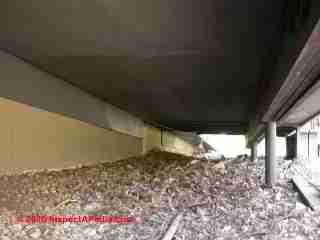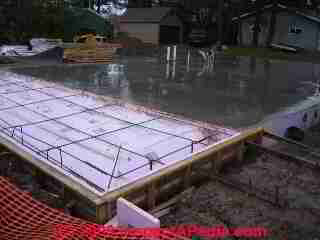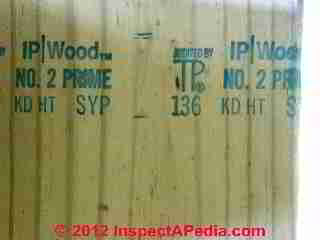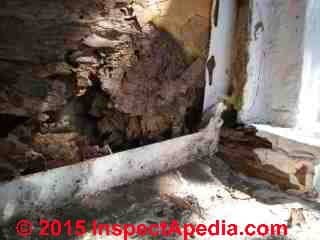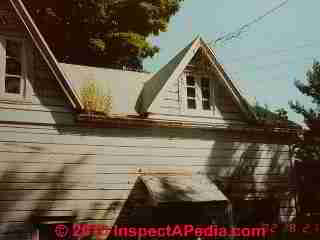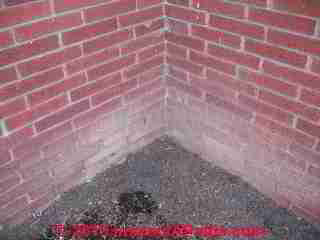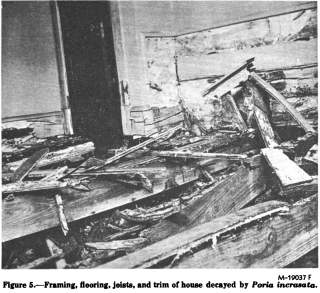 Meruliporia - "Poria" house eating fungus damage Prevention
Meruliporia - "Poria" house eating fungus damage Prevention
Good building practices reduce risk of Poria infection
- POST a QUESTION or COMMENT about house eating fungus: Meruliporia or Serpula molds in buildings
Here we cite expert advice on construction practices and home maintenance details that will reduce the risk of a future attack and damage by "Poria" the house-eating fungus.
Page top photo: extensive Poria incrassata damage to a wood-framed building. - (Verrall 1968)
This article series describes Meruliporia incrassata or "Poria" Meruliporia incrassata, previously named Poria incrassata which is better known among reporters and repairmen who see the public pale at reports of how the "house eating fungus destroys a home.
InspectAPedia tolerates no conflicts of interest. We have no relationship with advertisers, products, or services discussed at this website.
- Daniel Friedman, Publisher/Editor/Author - See WHO ARE WE?
Prevention: of Poria Fungus Damage in Buildings
 The water-conducting fungus, Poria incrassata (Berk. and Curt.) Burt, causes the most spectacular decay of wood in buildings in the United States.
The water-conducting fungus, Poria incrassata (Berk. and Curt.) Burt, causes the most spectacular decay of wood in buildings in the United States.
It produces large, tough, water-conducting strands (rhizomorphs) which, when rooted at a constant and abundant supply of moisture, can wet wood of a variety of species many feet away.
Thus the fungus can destroy wood normally too dry to decay. Attacks are not frequent, but the rapidity of attack and the extent of damage make this pathogen an important enemy of wood in service. - (Verrall 1968)
Photo: leaving un-treated wood forms in a concrete slab such a the one being prepared here at a home in Tucson increases the risk of a future termite or fungal attack on the building.
The steps listed below are adapted from (Verrall 1968) cited below.
- Use uninfected dry lumber for initial construction (6-12% moisture)
and never use lumber wet to over 14% moisture. If you see white mycelium or fans on construction lumber while in storage or before use in construction, don't use that wood. - Control soil moisture under & near the building
Roof drainage, gutters and downspouts must be working not just at time of construction but throughout the life of the structure, and surface runoff must be directed away from the building.
See CRAWL SPACE DRYOUT - home - Remove wood and trash around the foundation, don't allow contractors to dump wood forms, stakes, lumber scraps, or other organic trash into the excavation near the building foundation slab or walls - this measure reduces risks for both termites and Poria infestation.
- Remove stumps and wood debris from the building footprint before building the foundation, slab, etc.
- Avoid dirt-filled porches & terraces;
Where slab on grade is used the slab must not abut the building where it will contact wood framing or siding.
Detail:
Self - supporting slabs with a ventilated space below are preferable.
Dirt fills are safe, however, if the porch slab is below all wood framing or if the soil is enclosed in a separate foundation wall with sufficient space between the wall and the sill to permit inspection and ventilation.
Because dirt fills encourage termite attack, they should be well treated with an insecticide ( 40 ).
and
See WET BASEMENT PREVENTION for details.
- Elevate & waterproof slab-on-grade construction.
Detail: Self - supporting slabs with a ventilated space below are preferable.
Dirt fills are safe, however, if the porch slab is below all wood framing or if the soil is enclosed in a separate foundation wall with sufficient space between the wall and the sill to permit inspection and ventilation.
Because dirt fills encourage termite attack, they should be well treated with an insecticide ( 40 ).
- Keep crawl spaces & basements dry throughout the life of the building.
See CRAWL SPACE DRYOUT - home
and
See WET BASEMENT PREVENTION
Detail:
If the basement is damp, only pressure - treated wood should be used in contact with the walls and floor - even with 3 - inch concrete footings.
- Use treated lumber for any wood that must be close to or in contact with the ground
Details:
The need for treated wood varies with climate, soil moisture conditions, and building design. Climate has its greatest effect on decay associated with rain seepage, and least on decay by Poria incrassata .
In all parts of the United States pressure - treated wood or all heartwood of the most decay - resistant woods ( redwood, cedars ) should be used for the following items :
Sleepers in or on concrete laid on ground.
Sills or plates on concrete on ground.
Framing and sheathing in walls and floors of shower stalls.
Framing and sheathing in cold - storage rooms.
Wood used below first - floor joists in damp basements.
Similar wood should be used for critical items in regions with 25 inches or more of rain ( not total precipitation ) annually, or where swamps or seepage keeps the soil wet :
Frames for access doors in foundation walls.
Frames for outside doors into basements.
Furring strips below grade.
Sills or plates on concrete or masonry foundations less than 8 inches above grade.
Wood piers in crawl spaces with concrete footings less than 8 inches above grade.
Joists set into brick or concrete walls less than 8 inches above grade.
For wood in contact with the soil or continuously wet concrete or masonry, pressure treatment is a necessity. Naturally decay - resistant woods cannot be relied on.
Buildings of accepted design, such as houses conforming to the Federal Housing Administration's Minimum Property Requirements, are safe from the attacks of water - conducting fungi so long as the tenants do not nullify the design.
See details
at PRESERVATIVE TREATED FRAMING LUMBER
Photo: this extensive rot and insect damage to a building wall was found where someone poured a patio slab right against the wood-framed building wall.
- Avoid dangerous practices that invite termite or fungal attack on buildings
Examples of dangerous practices include the following:
Allowing downspouts to become clogged or rusted through.
Allowing roof drainge to spill around the building (clogged or missing gutters), especially where water splashes-up against or drains toward the building walls and foundation.
Building up flowerbeds so that soil touches siding.
Wetting wooden walls when sprinkling lawns. This practice has been sufficient, in new slab - on - ground houses whose owners were trying to establish lawns and shrubbery, to permit development of rhizomorphs connecting the sheathing and the soil.
Letting plumbing leak for protracted periods. Promptly repaired leaks are not serious.
Piling wood or other cellulosic material in crawl spaces or against sides of a house .
Above: two basic examples of building conditions inviting termite or mold damage:
When we see plants growing in roof gutters we know perfectly well that these gutters have been overflowing and spilling close to the building foundation and walls.
Roof spillage splash-up against the wall can bring both termites and fungal infection right through a brick veneer wall and into the wood structure. Details are
References on Poria, Identification, Properties, Damage, Prevention
- Verrall, Arthur Frederic. PORIA INCRASSATA ROT: PREVENTION AND CONTROL IN BUILDINGS. No. 1385. [PDF] US Department of Agriculture, Forest Service, 1968. Available as a free eBook courtesy of Google, at https://play.google.com/ books/ reader? id=YaMoAAAAYAAJ&hl=en&pg=GBS.PA1
This bulletin reviews the literature on Poria incrassata and summarizes 30 years of experience with its control in the South. ...
The water - conducting or building Poria was first described as Merulius incrassatus by Berkley and Curtis in 1849 from a sporophore on a pine stump in South Carolina. - Miller, Dini, SIGNS of SUBTERRANEAN TERMITE INFESTATION [PDF] Virginia Cooperative Extension, Virginia Tech / Virginia State University, retrieved 2020/11/23 original source: https://www.pubs.ext.vt.edu/444/444-501/444-501.html
- Money, Nicholas, P. PLAGUES UPON HOUSES AND CARS: THE UNNATURAL HISTORY OF MERULIPORIA [ODF] GEOFF GADD is Professor of Microbiology and Head of the Division of Environmental and Applied Biology at the University of Dundee.: 289. Department of Botany, Miami University, Oxford, Ohio
- Royes, Joy, and A. R. Loveless. "Poria carbonacea (Berk. & Curt.) Cooke as a cause of timber rot in Jamaica." Transactions of the British Mycological Society 43, no. 3 (1960): 571-577.
...
Continue reading at MERULIPORIA HOUSE EATING FUNGUS or select a topic from the closely-related articles below, or see the complete ARTICLE INDEX.
Or see these
Recommended Articles
- HIDDEN MOLD, HOW TO FIND
- MERULIPORIA HOUSE EATING FUNGUS
- MERULIPORIA FUNGUS & TERMITE INTERACTIONS
- PORIA DAMAGE PREVENTION
- PRESERVATIVE TREATED FRAMING LUMBER
- MILDEW ERRORS, IT's MOLD
- MOLD APPEARANCE - WHAT MOLD LOOKS LIKE - home
- MOLD ON DIRT FLOORS - where we have also identified this fungus.
- STRUCTURAL DAMAGE PROBING
- TERMITE DAMAGE PROBING
- TERMITE IDENTIFICATION & CONTROL
- WOOD STRUCTURE ASSESSMENT
Suggested citation for this web page
PORIA DAMAGE PREVENTION at InspectApedia.com - online encyclopedia of building & environmental inspection, testing, diagnosis, repair, & problem prevention advice.
Or see this
INDEX to RELATED ARTICLES: ARTICLE INDEX to MOLD CONTAMINATION & REMEDIATION
Or use the SEARCH BOX found below to Ask a Question or Search InspectApedia
Ask a Question or Search InspectApedia
Try the search box just below, or if you prefer, post a question or comment in the Comments box below and we will respond promptly.
Search the InspectApedia website
Note: appearance of your Comment below may be delayed: if your comment contains an image, photograph, web link, or text that looks to the software as if it might be a web link, your posting will appear after it has been approved by a moderator. Apologies for the delay.
Only one image can be added per comment but you can post as many comments, and therefore images, as you like.
You will not receive a notification when a response to your question has been posted.
Please bookmark this page to make it easy for you to check back for our response.
IF above you see "Comment Form is loading comments..." then COMMENT BOX - countable.ca / bawkbox.com IS NOT WORKING.
In any case you are welcome to send an email directly to us at InspectApedia.com at editor@inspectApedia.com
We'll reply to you directly. Please help us help you by noting, in your email, the URL of the InspectApedia page where you wanted to comment.
Citations & References
In addition to any citations in the article above, a full list is available on request.
- Verrall, Arthur Frederic. Poria incrassata rot: prevention and control in buildings. No. 1385. US Department of Agriculture, Forest Service, 1968.
- Alexopolous, C.J., C.W. Mims, M. Blackwell. 1996. Introductory Mycology, 4th ed. (or later) John Wiley & Sons, New York. 869pp.
- Kirk, Cannon, David, and Stalpers, "Dictionary of the Fungi," 9th Ed.
- Index Fungorum entry for Serpula lacrymans (Wulfen) J. Schröt., Meddn Soc. Fauna Flora fenn. 11: 21 (1885) http://www.indexfungorum.org/
- Neil Grieve. "Dry rot/Wet rot". The Conservation Glossary. University of Dundee.
- J.W. Palfreyman, The Domestic Dry Rot Fungus, Serpula lacrymans, its natural origins and biological control. Ariadne workshop 2001.
- Bagchee K. (1954) Merulius lacrymans (Wulf.) Fr. in India. Sydowia 8: 80–85
- Atlas of Clinical Fungi, 2nd Ed., GS deHoog, J Guarro, J Gene, & MJ Figueras, Centraalbureau voor Schimmelcultures, Universitat Rovira I Virgili, 2000, ISBN 90-70351-43-9
- "Management of Powdery Mildew, Leveillula taurica, in Greenhouse Peppers," Ministry of Agriculture and Lands, British Columbia - Original source: www.agf.gov.bc.ca/cropprot/peppermildew.htm
- Fifth Kingdom, Bryce Kendrick, ISBN13: 9781585100224, - we recommend the CD-ROM version of this book. This 3rd/edition is a compact but comprehensive encyclopedia of all things mycological. Every aspect of the fungi, from aflatoxin to zppspores, with an accessible blend of verve and wit. The 24 chapters are filled with up-to-date information of classification, yeast, lichens, spore dispersal, allergies, ecology, genetics, plant pathology, predatory fungi, biological control, mutualistic symbioses with animals and plants, fungi as food, food spoilage and mycotoxins.
- Our recommended books about building & mechanical systems design, inspection, problem diagnosis, and repair, and about indoor environment and IAQ testing, diagnosis, and cleanup are at the InspectAPedia Bookstore. Also see our Book Reviews - InspectAPedia.
- In addition to citations & references found in this article, see the research citations given at the end of the related articles found at our suggested
CONTINUE READING or RECOMMENDED ARTICLES.
- Carson, Dunlop & Associates Ltd., 120 Carlton Street Suite 407, Toronto ON M5A 4K2. Tel: (416) 964-9415 1-800-268-7070 Email: info@carsondunlop.com. Alan Carson is a past president of ASHI, the American Society of Home Inspectors.
Thanks to Alan Carson and Bob Dunlop, for permission for InspectAPedia to use text excerpts from The HOME REFERENCE BOOK - the Encyclopedia of Homes and to use illustrations from The ILLUSTRATED HOME .
Carson Dunlop Associates provides extensive home inspection education and report writing material. In gratitude we provide links to tsome Carson Dunlop Associates products and services.


